Pack your bags and fasten your seatbelts! We’re about to embark on an exciting culinary adventure across six of the world’s most iconic fish markets. Each market offers a unique glimpse into the local culture, cuisine, and community. From the bustling streets of Tokyo to the scenic harbor of Reykjavik, our journey promises to be both educational and exhilarating.
Imagine stepping off a plane into the early morning mist of Tokyo. The air is crisp, and the anticipation of what awaits fills you with excitement. By day, we’ll explore the vibrant aisles of fish markets, where the freshest catches and unique seafood delicacies beckon. We’ll immerse ourselves in the local culture by night, savoring dishes crafted from the day’s finds.
Our itinerary includes:
- Tsukiji Fish Market in Tokyo, Japan: Known for its legendary tuna auctions and an incredible variety of seafood.
- Pike Place Fish Market in Seattle, USA: Famous for its lively fish-throwing tradition and artisanal foods.
- Funchal Fish Market in Madeira, Portugal: Renowned for its exotic black scabbardfish and vibrant market atmosphere.
- The Fish Market in Kolkata (Calcutta), India, is a bustling hub of activity with an impressive array of fish and seafood.
- Darajani Fish Market in Zanzibar, Tanzania: A historical market offering a rich selection of fresh seafood and a glimpse into Swahili culture.
- Reykjavik Harbor Fish Market in Iceland: A modern market showcasing the freshest catches in a stunning harbor setting.
Join us as we traverse continents, exploring the heart and soul of these remarkable fish markets. Each destination offers a unique experience, revealing the vital role of seafood in the local diet and culture. Later, we will look at Bulgarian sea traditions and local fish markets. Now, let’s board our plane and set off on this global culinary adventure—our first stop: Tokyo, Japan, and the world-famous Tsukiji Fish Market.
Day 1: Tsukiji Fish Market, Tokyo, Japan
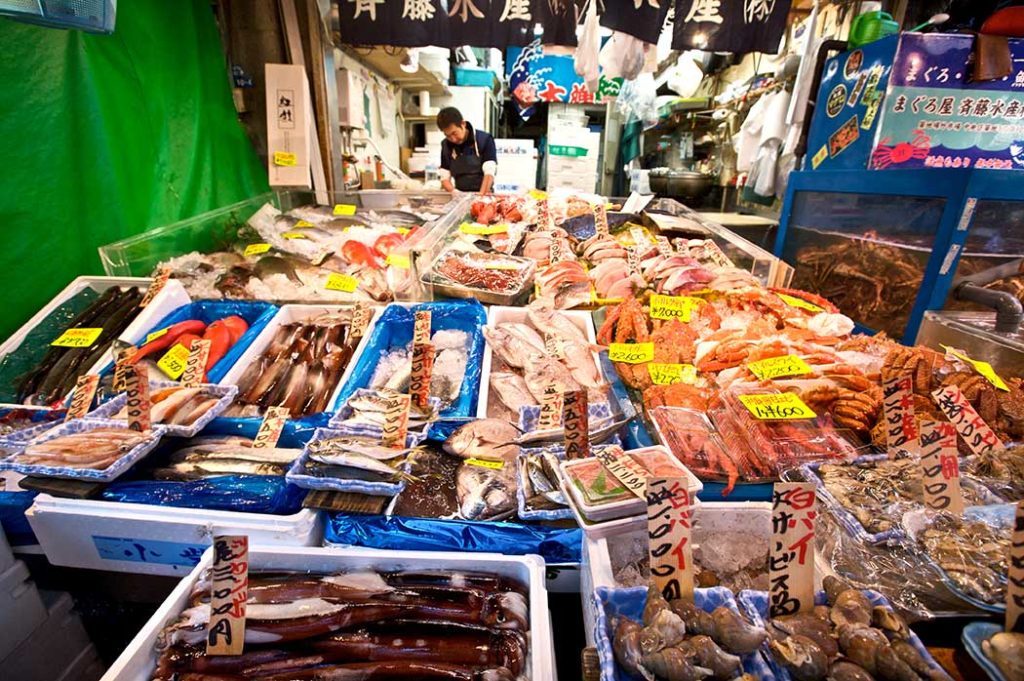
Our first stop on this culinary adventure is the legendary Tsukiji Fish Market in Tokyo, Japan. As the largest fish market in the world, Tsukiji handled an astonishing 2,200 tons of seafood daily, with an average turnover of USD 28 million per day, amounting to approximately USD 7.5 billion annually. Around 65,000 people worked here, contributing to its bustling, energetic atmosphere.
At the heart of Tsukiji was the inner market, or jonai shijo, where over 900 wholesalers operated. The famed tuna auctions in this section drew crowds of licensed bidders. The auctions began early, around 5:20 AM, and concluded by 7:00 AM. Only licensed participants, including wholesalers, market stall operators, and agents for restaurants and large retail chains, were allowed to bid. One of the most famous auction records was set on January 5, 2012, when the owner of Sushi-Zanmai, a sushi restaurant chain, purchased a 269-kilogram bluefin tuna for an astounding USD 736,000. Such high-profile bids were often made for publicity, while regular tuna prices were significantly lower.
Beyond the inner market, Tsukiji’s outer market, or jogai shijo, was a lively mix of wholesale and retail vendors. This area offered everything about seafood, from kitchen tools and small seafood shops to bustling sushi restaurants. Visitors could explore the market and sample the freshest seafood from early morning until around 11:00 AM, when many shops began to close. The inner market itself shut down for cleaning around 1:00 PM.
Tsukiji opened daily at 3:00 AM, with peak activity between 5:30 and 8:00 AM. Seafood arrived by ship, truck, and airplane from all corners of the globe. The market’s vibrant hustle was a testament to its importance in the global seafood trade.
A unique aspect of Japan’s wholesale fish trade is the significant role played by local authorities and central wholesale markets. Prices were fixed based on auction results, ensuring transparency and fairness, thus preventing speculative price manipulation. This system replaced the previous practice of secretive negotiations between sellers and buyers, which often led to inefficient and unfair transactions.
While Tsukiji Fish Market has since relocated to the new Toyosu Market, its legacy remains alive. The outer market continues to thrive, and visitors can still experience the vibrant atmosphere that made Tsukiji a world-renowned destination. To stay updated on the latest happenings, visit the official Tsukiji website or follow news on Minato-Tsukiji.
As we leave Tokyo, the echoes of the bustling market linger in our minds, and we look forward to our next destination. Our journey continues as we head across the Pacific to Seattle, USA, to visit the iconic Pike Place Fish Market.
Day 2: Pike Place Fish Market, Seattle, USA
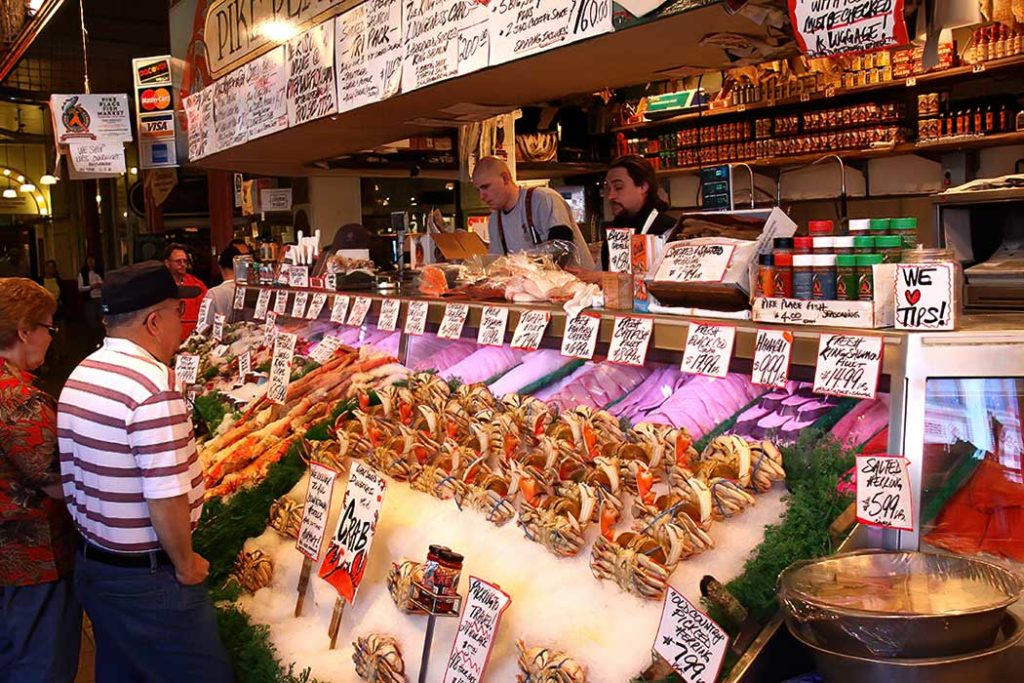
Our culinary journey continues as we touch down in Seattle, USA, home to the iconic Pike Place Fish Market. Founded in 1907, Pike Place is Seattle’s oldest market and a renowned tourist attraction. The market is best known for its “flying fish” tradition, where fishmongers toss hefty salmon, delighting and surprising onlookers.
This playful practice started as a clever tactic to attract customers. When sales were slow, vendors would throw fish in front of their stalls to startle passersby and grab their attention. The fish-throwing has become a beloved spectacle today, symbolizing the market’s lively and interactive spirit. Visitors often flock to see the fishmongers expertly tossing fish to one another, creating a vibrant and entertaining atmosphere.
Pike Place Fish Market is famous for its fresh seafood, salmon, and monkfish. The market’s interactive approach to selling fish began in 1986 when it was on the brink of bankruptcy. Instead of closing down, the market transformed its business model by encouraging vendors to engage more actively with customers. This shift saved the market and made the flying fish a hallmark of Pike Place.
While at Pike Place, indulge in the local seafood prepared fresh at the market’s many small restaurants. A must-visit is The Pink Door, located in Post Alley, known for its delicious seafood dishes and charming ambiance. For a romantic dining experience, Il Bistro offers classic seafood delicacies alongside Italian pasta, providing a perfect blend of flavors. If you’re looking for something unique, try Copacabana, the only Bolivian restaurant in Seattle near Triangle Market.
Pike Place Market is not just about seafood. The historic district also features artisanal foods, crafts, and the original Starbucks, making it a cultural hub of Seattle. Exploring the market, you’ll encounter a mix of old-world charm and modern vitality, reflecting the city’s maritime heritage and community spirit.
To learn more about Pike Place Fish Market, visit the official website of the World Famous Fish Market in Seattle, WA.
As we leave the lively streets of Seattle, we carry with us the echoes of flying fish and the taste of freshly prepared seafood. Our next destination awaits: the picturesque island of Madeira, Portugal, where the Funchal Fish Market offers another unique experience in our global culinary adventure.
Day 3: Funchal Fish Market, Madeira, Portugal

Our culinary adventure continues as we land on the picturesque island of Madeira, Portugal, to explore the vibrant Funchal Fish Market, also known as Mercado dos Lavradores. This market is undoubtedly one of the island’s most colorful and lively places, offering visitors a glimpse into the local culture and cuisine.
As you enter the market, the vibrant displays of fresh fish, fruits, vegetables, and flowers immediately catch your eye. It’s a sensory feast, with the scents of the sea mingling with the aromas of ripe tropical fruits. The market is particularly famous for its fresh tuna, which you can see in impressively large sizes. Typical Madeiran fish like barracuda, grouper, striped jack, and local gobies are plentiful.
However, be mindful that Funchal Fish Market is a popular tourist attraction, and prices can be inflated. For example, the unique monstera deliciosa, a fruit that tastes like a blend of banana and pineapple, is often sold on the main floor at high prices. Savvy shoppers might find better deals by venturing to the second floor, where they can also enjoy a panoramic view of the bustling market below.
While exploring the market, you’ll notice numerous small restaurants where you can select your seafood and have it cooked to your liking. This interactive dining experience is a highlight for many visitors but beware: once vendors realize you’re a tourist, prices can skyrocket, sometimes five to ten times higher than usual. Despite this, the market remains a must-visit spot for its lively atmosphere and vibrant photo opportunities.
The Madeirabirds website describes the local fish species and their habitats.
Although the market’s pricing strategy might deter some, its charm and cultural significance make it a worthy stop on your Madeiran itinerary. The surrounding area also offers plenty of small eateries where you can enjoy fresh seafood away from the tourist crowds.
As we leave the colorful stalls of Funchal Fish Market, the taste of fresh seafood still lingering, we prepare for our next stop. Our journey now takes us to the bustling city of Kolkata, India, where the local fish market promises yet another fascinating culinary experience.
Day 4: The Fish Markets in Kolkata, India
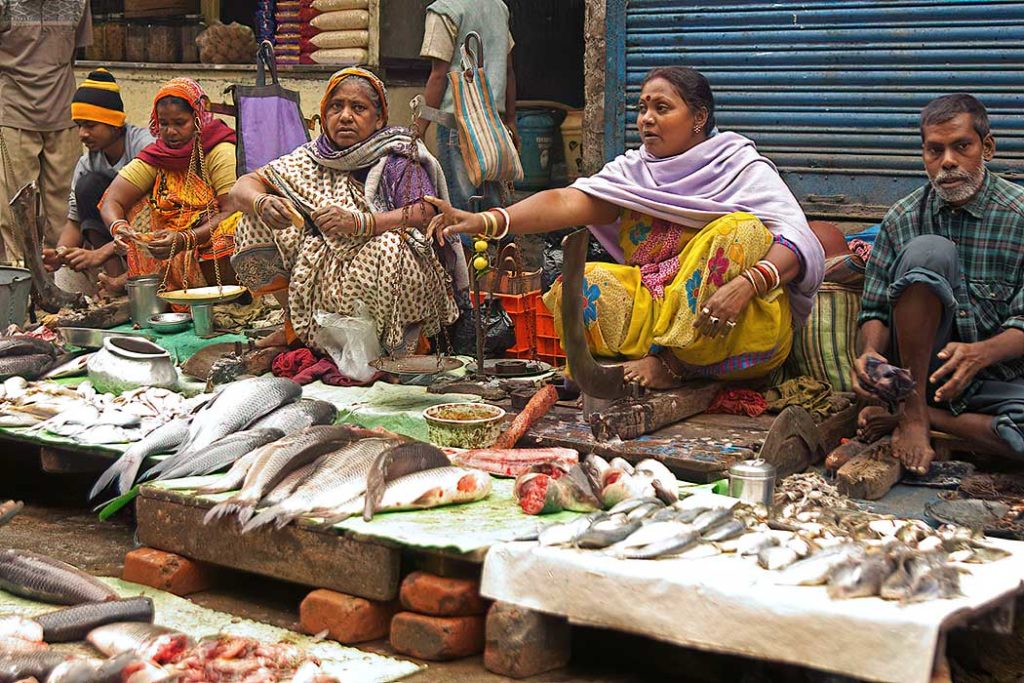
Our journey now brings us to the vibrant city of Kolkata in the Indian state of West Bengal. Kolkata, known for its rich cultural heritage and bustling markets, offers a unique experience with over 160 designated open-air and covered markets, more than half selling fish. These markets are regulated by the West Bengal Marketing Board, which ensures their smooth operation and publishes a list of markets on its website.
Kolkata’s connection to the sea is evident in its cuisine, with one of the most typical dishes being fish cooked with rice and local spices. Although Kolkata is about 40 kilometers inland from the Bay of Bengal, it is linked to the sea via the Hooghly River. With a city population of over 7 million and a metropolitan population exceeding 16 million, Kolkata is a bustling hub of activity.
The fish markets here are a feast for the senses, particularly intriguing to European visitors. The vendors and their wares offer a colorful display, and the markets showcase local customs and cultural practices. Bargaining is an integral part of the shopping experience, and the locals take buying and selling goods very seriously. Unlike in many other parts of the world, prices are not typically displayed, and the focus is on negotiating a fair price that satisfies both buyer and seller.
Despite the proximity to the Bay of Bengal and the abundance of fresh fish, hygiene standards can be a concern in some areas. If you are unfamiliar with the local nuances, observing rather than purchasing fish yourself is advisable.
Typical fish found in Kolkata’s markets include tilapia (up to 100 Rs), rohu fish (up to 160 Rs), and bhetki fish (up to 340 Rs). These prices generally include free transport and delivery, a common practice in the region.
Kolkata’s fish markets are not just about the fish but about the experience. The lively banter, the vibrant colors, and the rich aromas contribute to the market’s unique atmosphere. Each visit offers a deeper understanding of the local way of life and the cultural significance of fish in the daily diet.
As we depart from the bustling streets of Kolkata, the sounds and scents of the market linger in our minds. Our next destination is the exotic island of Zanzibar in Tanzania, where the Darajani Fish Market promises another captivating experience in our global culinary journey.
Day 5: Darajani Fish Market, Stone Town, Zanzibar
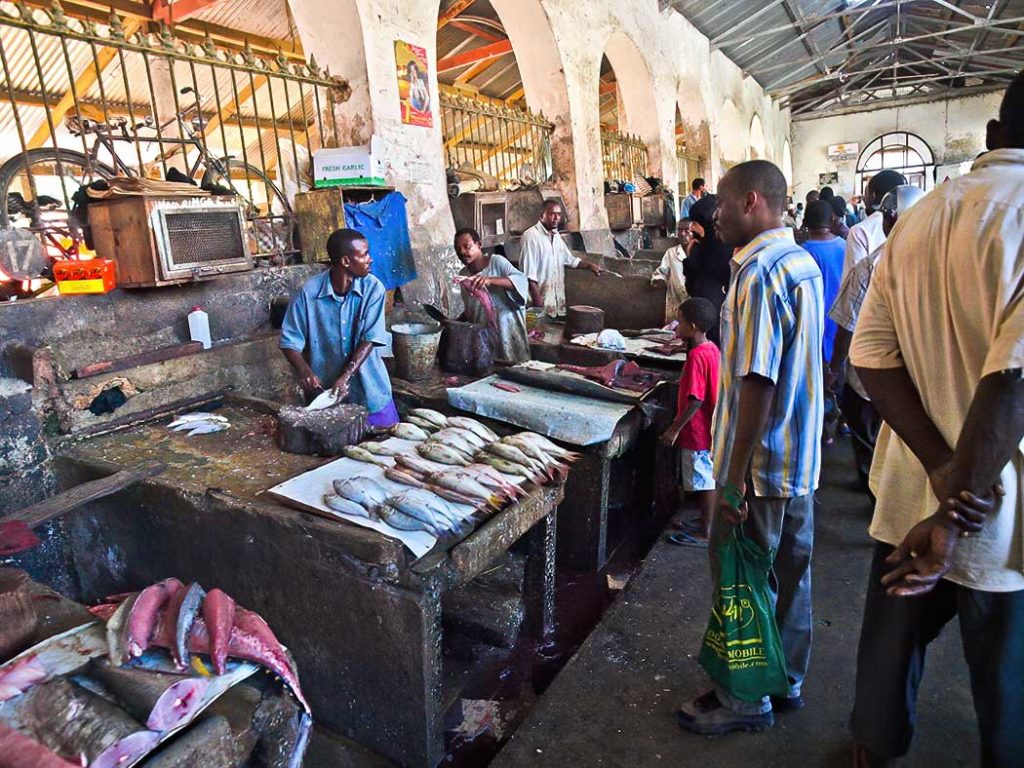
Our global culinary journey now takes us to the exotic island of Zanzibar in Tanzania, where we visit the bustling Darajani Fish Market in Stone Town. Also known as Estella Market, named after Countess Estella, sister of Lloyd Mathews, a former Prime Minister of Zanzibar, this market has been a vibrant hub since it opened its doors in 1904.
Zanzibar’s climate and rich marine life make its fish markets some of the most fascinating and diverse in the world. Darajani Fish Market is no exception. Here, locals buy and sell a wide array of seafood, fruits, vegetables, meat, spices, and colorful fabrics. The market is a sensory feast, with the sights, sounds, and scents of fresh produce and spices creating a vibrant and dynamic atmosphere. If you’re planning a trip to Zanzibar, visiting Darajani Fish Market will give you an authentic taste of local life.
The market’s main building often overflows with vendors and goods, spilling into the surrounding streets. The market is busiest between 9 and 11 AM, with energy as people haggle over prices and socialize. The friendliness of the vendors is notable; they are always ready to help you choose the best tea or spices, often at prices much lower than what you would find elsewhere. Remember, when taking photos, especially portraits, it’s courteous to ask for permission first.
Saturdays and Wednesdays are particularly lively, with the usual hustle and bustle amplified by antique traders who add to the market’s vibrant mix. This is the perfect time to experience the market in its full glory and capture some memorable photographs.
The Darajani Fish Market is not just a place for transactions; it’s a cultural epicenter where traditions and modern life intersect. The market’s proximity to the Anglican Cathedral adds a historical layer to your visit. The cathedral stands on the site of a former slave market, a sad reminder of Zanzibar’s past, which was abolished in 1873.
As we leave the vibrant streets of Stone Town, the rich aromas of spices and the lively sounds of the market stay with us. Our journey now takes us to the calm shores of Reykjavik, Iceland, where the Reykjavik Harbor Fish Market awaits, promising another unique and captivating experience on our global culinary adventure.
Day 6: Reykjavik Harbor Fish Market, Iceland
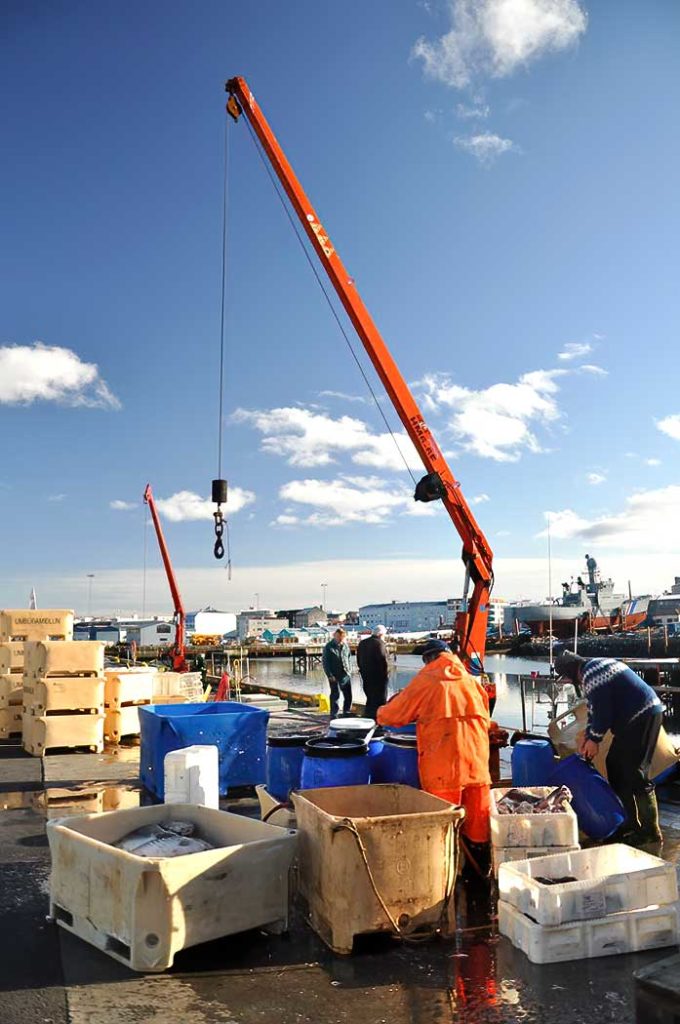
Our final destination brings us to the northern reaches of the globe, to the scenic harbor of Reykjavik, Iceland. With a territory comparable to Bulgaria, Iceland is sparsely populated, home to just 320,000 people, with around 120,000 residing in Reykjavik. Iceland’s significant economic progress began after gaining independence in 1944, transforming from a poor island nation to a prosperous country.
Iceland’s natural resources are limited, leading to a heavy reliance on industries like fishing, mineral processing for aluminum production, and pharmaceuticals. The landscape around Reykjavik is predominantly covered in rocky formations of solidified lava, barren humus, and perennial vegetation. The Viking settlers deforested the island to build ships and introduced goats, further decimated the vegetation. Today, only 3% of Iceland’s land is forested, a stark reminder of its ecological history.
Given these conditions, Iceland’s economy and society are closely tied to the ocean and fishing. Cod is the most significant fish for Iceland, both economically and culturally. In addition to wild-caught cod, aquaculture production has increased to meet market demands. Other notable fish include haddock, pollock, ling, and herring.
The old fishing harbor in Reykjavik, located near the city center, now holds more historical and tourist value. Industrial fishing has shifted commercial activities to a modern fishing harbor in the industrial suburbs of Reykjavik. However, the old harbor area still offers several small restaurants where visitors can enjoy fresh ocean fish. Dining here provides a taste of Iceland’s maritime heritage, with over 200 seafood restaurants in the city.
The modern Reykjavik Harbor Fish Market is a bustling hub of activity. Here, you can witness various fish being processed, including the occasional minke whale. Iceland operates under a quota system that allows limited whaling, with most of the catch remaining in Iceland. Some of it is exported to Japan, and rumors suggest that a portion finds its way to the European black market, where whaling is prohibited.
As we explore the market, the array of seafood is impressive, with fresh catches displayed in abundance. The market’s atmosphere blends traditional fishing practices and modern efficiency, reflecting Iceland’s strong ties to the ocean. Visiting the Reykjavik Harbor Fish Market offers a unique insight into the country’s fishing industry and its importance to Icelandic culture and economy.
Reflections
As our plane returns, we reflect on our incredible journey across the world’s iconic fish markets. From the lively auctions at Tokyo’s Tsukiji Fish Market to the interactive fish-throwing at Seattle’s Pike Place, each destination offered a unique and immersive experience of the local culture and cuisine.
In Madeira, the vibrant Funchal Fish Market showcased the island’s rich maritime and agricultural traditions despite the tourist-inflated prices. Kolkata’s bustling fish markets provided a colorful and authentic glimpse into the daily life of this Indian metropolis, where bargaining is an art form. The historic Darajani Fish Market in Zanzibar brought us face-to-face with the island’s deep-rooted traditions and lively trading atmosphere, a reminder of the region’s vibrant cultural heritage.
Finally, our journey concluded in Reykjavik, Iceland’s cool, crisp air. The modern fishing harbor highlighted the country’s reliance on the sea and its significant economic progress. Seeing freshly caught cod and other fish underscored Iceland’s strong ties to the ocean and its commitment to sustainable fishing practices.
Throughout our travels, we witnessed how these fish markets are more than mere places of commerce. They are cultural epicenters where tradition meets modernity, and locals and tourists gather to experience the freshest seafood and the bustling market life. Each market offered us a taste of the local way of life, from the intricate bargaining in Kolkata to the community spirit in Seattle.
These markets are vital to the local economies, providing livelihoods for thousands and feeding millions. They also testify to the diverse culinary traditions that define each region. Visiting these markets is a captivating way to explore the world’s culinary and cultural richness, offering a deeper understanding of the importance of seafood in global cuisine.
As we conclude our journey, we invite you to explore these fish markets for yourself. Whether you’re a foodie, a traveler, or simply curious, these markets offer a unique and enriching experience. So pack your bags, book your tickets, and dive into the vibrant world of fish markets. Bon voyage and happy exploring!
For all our travel needs outside of Bulgaria, we always trust United Travel Agency in Sofia. Let them make your next adventure unforgettable!



